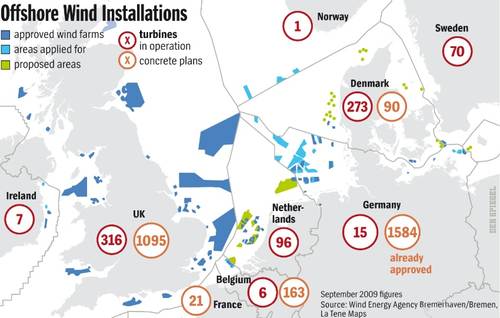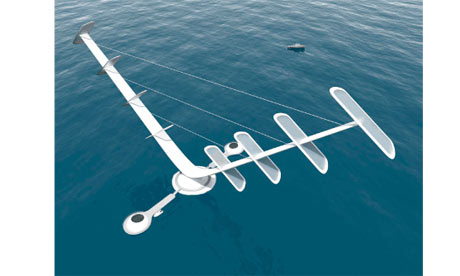The Morrow County Planning Board ruled this week that the Willow Creek Energy Center, an 80-turbine wind farm, is producing noise levels that violate Oregon’s noise limits, and gave Invenergy, the wind farm’s owner, six months to get the turbines into compliance. The wind farm began operating in January 2009, and by March, several neighbors within a half mile had raised serious concerns about the noise (see this article for details), including regularly having difficulty sleeping. Noise monitoring then took place, and in January of this year, the Planning Board received the results, which showed that noise levels at four homes sometimes exceeded the limit of 37dB.
There was some contention at that meeting, as neighbors had hired independent noise monitoring consultants, whose records showed more consistent violations than those of the Invenergy-hired consultant; the differences were pegged to the fact that the Invenergy consultant did not record in high wind speeds, contending that the noise gets no louder above wind speeds of 9m/s. It is unclear from initial news reports whether the wind farm will be required to comply with the noise limits based on the Invenergy sound monitoring protocol, which found excess noise just 10% of the time at one house, and less frequent slight violations at three others, or whether they’ll use the more comprehensive techniques used by the local citizens, which found violations more consistently at two homes (one just over the limit, the other often over 40dB), with one home experiencing excess noise on 22 out of 37 nights.
Carla McLane, Planning Director for Morrow County, noted that while the commission did rule the wind farm was violating state regulations, it found the turbines only crossed the noise threshold at certain times of day and under certain conditions. “Some would want to view it in black and white and if it’s a violation then you have to shut them down,” McLane said. “Others would want to view it in terms of shade of gray and say it’s not an ongoing and continuous violation. It’s an intermittent violation.”
”I’m not sure how someone can say this is an unusual, infrequent event,” said Kerrie Standlee, one of the neighbors’ noise consultants. “To me, 59 percent (of nights with excess noise) is not occasional or unusual.” Standlee’s noise study also went beyond Invenergy’s in that he gave the residents a sheet of paper to log their experiences with time and date. He then overlaid those comments on the data and showed that when the residents reported high noise, the wind was blowing from a particular direction or at a particular speed. This last bit of information may offer Invenergy some direction about when they might shut down turbines if they want to avoid the worst of the noise issues, during the six months they have to get into compliance.
The Planning Board struggled with the conflicting approaches, according the the East Oregonian (article archived here). “I have a very hard time coming to a concrete conclusion on which study I feel is accurate,” Commissioner Pamela Schmidt said. “I’m not a licensed engineer in acoustics myself and there’s been so much information I can’t make a decision.” Invenergy claimed that the background ambient noise varies, so that in higher wind periods, it should be allowed to exceed 36dB; yet, in its permit, it used the 26dB ambient standard, which is the state’s default if measurements are not made ahead of time. Complicating matters more is the fact that, as the East Oregonian noted, “the rule does not direct agencies on how to administer the rule or decide conflicts such as the one between Invenergy and its neighbors. The agency that originally enforced the rule, the Oregon Department of Environmental Quality, has since defunded and destaffed its noise program.”
It’s worth noting that the noise issues seem to be quite pronounced even at sound levels of 40dB. Oregon’s 36dB limit is among the most conservative in the country; it’s based on being 10dB above average night time ambient noise levels, which have been measured at 26dB. It appears that noise issues may well be present even when the measured sound levels are at or very near 36dB; this is in synch with reports from elsewhere, which suggest that people accustomed to quiet rural night time soundscapes are quite easily disturbed when turbine noise becomes one of the loudest local sounds, even when absolute noise levels are not extreme. In general, acousticians consider a sound to become readily audible when it is 5dB above ambient, with disturbance considered likely when it reaches 10dB above ambient.
UPDATE, June 2011: The state Land Use Board of Appeals issued a ruling that questioned the county’s interpretation of the 36dB noise limit. In its ruling, LUBA sided with the wind developer, which had said that the state laws allow wind farms to produce up to 10dB more than ambient sound levels; the county had been suggesting that if the developer doesn’t conduct ambient noise studies before construction, they must assume ambient of 26dB (typical night time ambient). The LUBA decision said that this requirement to choose whether or not to do an ambient study prior to construction did not appear in the state rules, leaving room for companies to show later that measurements of turbine noise levels exceeding 36dB were made when the ambient was above 26dB.



